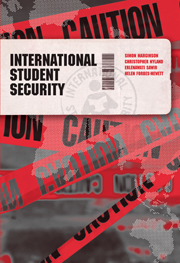Book contents
- Frontmatter
- Contents
- List of figures
- List of tables
- About the authors
- Preface
- PART 1 Students in the global market
- PART 2 Security in the formal and public domain
- PART 3 Security in the informal and private domain
- 11 The universities
- 12 Language
- 13 Family and friends
- 14 Loneliness
- 15 Intercultural relations
- PART 4 Protection and empowerment
- References
- Index
14 - Loneliness
Published online by Cambridge University Press: 05 August 2012
- Frontmatter
- Contents
- List of figures
- List of tables
- About the authors
- Preface
- PART 1 Students in the global market
- PART 2 Security in the formal and public domain
- PART 3 Security in the informal and private domain
- 11 The universities
- 12 Language
- 13 Family and friends
- 14 Loneliness
- 15 Intercultural relations
- PART 4 Protection and empowerment
- References
- Index
Summary
I think the biggest problems most international students face is that of loneliness, and I mean it really gets to the point of depression. Some of the people I know that I've met, it's really … they don't know what to do, they don't know who to go to, because they have come from countries where it is not acceptable to go and ask for help. You have to do it yourself.
~ male, 29, business, IndiaINTRODUCTION: THE LONELINESS OF THE LONG-DISTANCE STUDENT
Not all international students are secured all the time by bonding relations. Often networks with family and friends are attenuated by distance or by cultural displacement just when they are most needed. For others traditional bonds do not meet all their needs for sociability. Many experience loneliness during their stay. For some loneliness becomes a permanent condition that constrains their agency.
A person is lonely when the need to belong is unsatisfied. As with feelings of hunger, joy and sorrow, loneliness is a human condition that almost everyone has known. Feelings of loneliness cannot be wholly eliminated but they can be modified through the actions of the agent and/or others. Loneliness is more likely to occur under circumstances such as prolonged foreign travel or the loss of significant others. It is one of the defining features of the international student experience.
- Type
- Chapter
- Information
- International Student Security , pp. 365 - 391Publisher: Cambridge University PressPrint publication year: 2010



